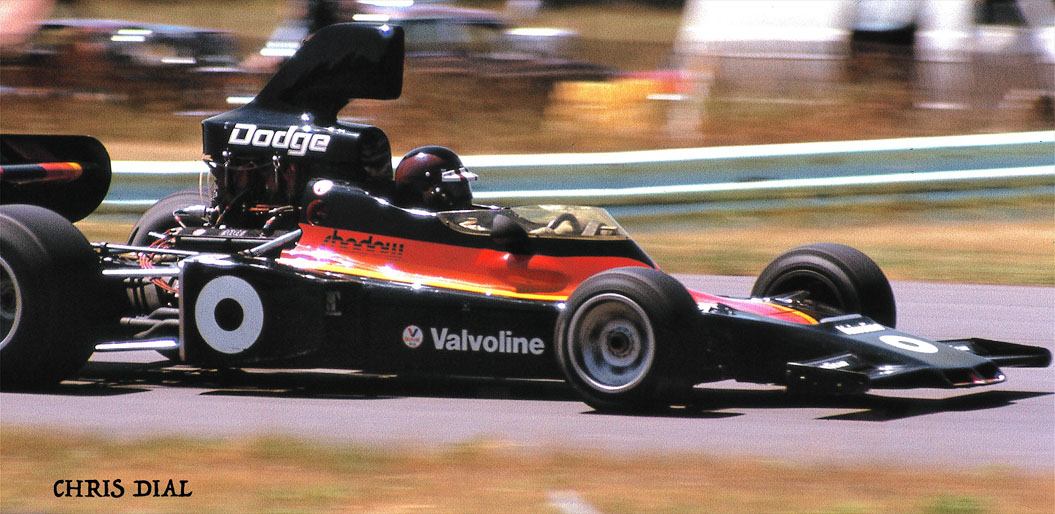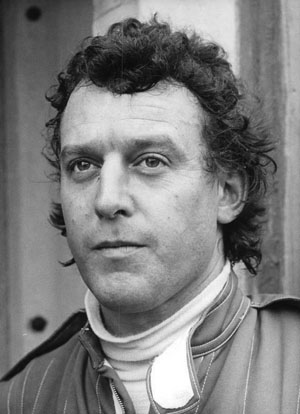Keith Jack “Jackie” Oliver (born 14 August 1942 in Chadwell Heath, Essex) is a British former Formula One driver and team-owner from England.
He became known as the founder of the Arrows team as well as a racing driver, although during his driving career he won both the 24 Hours of Le Mans race and the Can-Am championship. Info from Wiki
Bio by Stephen Latham
Jackie Oliver raced in Grands Prix for Lotus, BRM, McLaren and Shadow and later became a founder of the Arrows team. In his first home GP, he was leading and en route to a fairytale win when the car failed though he won a string of long-distance sports car classics (including a Le Mans victory for Ford) and was Can-Am Champion.
His father had a prosperous refrigeration business and owned a number of prestige cars but during the evenings a young Jackie used to take the keys and sneak the cars out for a drive. He told how he would “open the garage doors, roll it back onto the road, start it up, and go and show off to my mates in the Green Tiles Cafe. Race up and down the Southend Arterial Road in the middle of the night. I remember peering through the steering wheel of his Facel Vega because I couldn’t see over it…The hard thing was getting back into the garage, because it was uphill from the front gate. I had to come roaring down the road, switch off, and swing in the gate fast enough to coast up into the garage. Then slip the keys back into the bowl in the hall.”
He started in motorsport with a Mini, which would be driven on the road to race at Brands and Snetterton, and following this was a Marcos. After wrecking it at Snetterton, another Marcos was obtained (raced as Ecurie Freeze) plus he also raced his father’s business partner Ken Baker’s E-type and a Mustang. Then came a Lotus Elan and he came to people’s attention after a number of impressive performances, with wins and podiums at Brands Hatch, Crystal Palace, Monthlery, Croft, Snetterton and Rufforth.
In 1966 he was signed by Lotus for their F3 team, Charles Lucas Team Lotus, and went on to finish third in the Les Leston championship. 1967 saw him in F2 with a Lotus Components run Lotus and he came fifth overall and won his class at the German GP plus also took a class win in Oulton Park’s Gold Cup and victory at the Nurburgring. He also took victories with a Mustang at Silverstone, Snetterton and Brands Hatch and shared a Lotus 47 with John Miles in the Brands Hatch BOAC 500 race. In 1968, he was called up by Team Lotus to partner Graham Hill after the tragic death of Jim Clark. His first F1 race was at Monaco and he told how, before the start Colin bent down into the Lotus 49’s cockpit and said to him, “Lad, in the whole history of this race there have never been more than six finishers.’ Not quite true, but I got the point. Whatever I did, I had to finish. First lap, coming out of the tunnel, lit by about one 25-watt bulb in those days, into the bright sunlight, Bruce McLaren hit the barrier and tore off a wheel. Scarfiotti’s Cooper slewed sideways to avoid him. I arrived and had nowhere to go. Tore two wheels off. Lap one. I walked back to the pits. Colin, bent over his lap chart, didn’t even look up. ‘You f***ed that up, didn’t you. You’re fired.” There would be a number of frustrating retirements, and he was even leading the British GP until an engine failure forced him out, and best results were fifth in Belgium and third at Mexico.
In the following year he switched to BRM but the two seasons with them would prove to be disappointing, with his best results being seventh in South Africa, sixth in Mexico, fifth in Austria and seventh in Mexico. He had been running a strong third for most of the Dutch and British races though he finished fifth in the Race of Champions and third in the Oulton Park Gold Cup. However, there were highlights during 1969 with victories in endurance racing, at Le Mans and Sebring in a Gulf Ford GT40 (with Jackie Ickx). He made his debut in CanAm and at St Jovite, he qualified the Autocoast Ti-22 third behind behind Dan Gurney and Denny Hulme. But during the race air got under the car and it reared up and performed a complete backflip before landing and sliding on its nose. Fortunately the titanium chassis absorbed all the damage and enabled him to escape virtually unharmed.
There were further Can Am outings the following year, taking second place finishes at Laguna Seca, Riverside and Mosport, plus he shared a Porsche 917 to victories at Daytona, Spa and Monza. Racing a Lola T70 he was fourth in Buenos Aires and eleventh in the 1000Km with Carlos Reutemann. Continuing in 1971 he took third at Edmonton in a CanAm race for Shadow and third in a Riverside TransAm race with Penske. In the World Sportscar Championship he won the Daytona 24 Hours, the 1000 km Monza and the Spa 1000km races with Pedro Rodriguez in a Porsche 917; he also clocked the fastest lap ever around Le Mans during the April test weekend at an average of 153.53mph, doing well over 240mph on the old Mulsanne Straight.
There was no full time F1 drive in 1971, though he had three drives in a third McLaren, but hopes of a full time drive for 1972 were dashed when Peter Revson opted for F1 over USAC. 1972 saw him concentrate mainly on CanAm with Shadow, but though there was one race for BRM at the British GP at Brands Hatch he retired due to suspension problems.
Then came a full time return to F1, racing Shadow’s DN1 alongside George Follmer but his season was derailed by mechanical problems. However, he ran strongly in Canada, with many believing he actually won the race, but the lap charts were thrown into confusion by a rain shower meaning multiple pit-stops. At the pit stops, a number of drivers came in but had to drive through as there was no space for them to be serviced in the small, busy, pit lane. Also, when a safety car was deployed it stayed in front of the wrong car by mistake which allowed several drivers to gain a lap on the field. He was eventually classed as the third place finisher.
In 1974’s CanAm season he took second and third place finishes at Laguna Seca and Edmonton on his way to the series title for Shadow. He was becoming more involved in the management side of Shadow, but would compete in Formula 5000 for the team for three seasons. He even briefly returned to F1, stepping in to finish fifth in 1977’s Race of Champions and ninth in the Swedish Grand Prix. Alan Jones then joined the team for Long Beach and would later win in Austria, taking Shadow’s only Grand Prix victory. There were also a third place finish at Monza, and fourth places at Mosport and Fuji before he moved on to Williams.
He had been racing a Chevrolet Camaro in the IROC series and Bill France asked him to race in NASCAR. He described this as a ‘learning curve’ and “the guys called me the Little Limey, and the only thing that impressed them was my ability to control a slide. The rest of it, I was rubbish. I had plenty of accidents, 180mph backwards into the wall, but I never hurt myself. It was all ovals, the big superspeedways, and the little mile ovals. With those you’re always in a bloody corner. My pec size went up an inch and a half. Everybody used to cheat like hell, and the only sin was getting caught. Most of the races were in the Deep South: a barbecue on a warm evening around the pool at some Holiday Inn, somebody playing a guitar and all the drivers singing Country & Western songs. It was a long way from F1.”
At the end of 1977 he left Shadow, along with financer Franco Ambrosio, engineer Dave Wass plus designers Tony Southgate and Alan Rees, to form the Arrows Grand Prix team, with Ricardo Patrese as driver. The team was originally to be called Ambrosio (after their Italian sponsor) and Gunnar Nilsson was the intended No 1 driver, but tragically he never got to drive due to his cancer. They were eventually titled Arrows (the name being derived from Ambrosio, Rees, Oliver, Wass and Southgate) and work started on the first Arrows A1 on December 12. With virtually no break the car was presented to the press in late January and Ricardo Patrese raced it in the Brazilian GP at the end of Jannuary, finishing tenth despite a fuel feed problem. It almost won its second race, at Kyalami, as Ricardo was well in the lead with 15 laps remaining until the engine blew. Rolf Stommelen had joined the team by this time and they had sponsorship from the Warsteiner brewery company. During this period, Franco Ambrosio was jailed in Italy for financial irregularities and the team were sued by Don Nichols and Shadow for copyright infringement so Arrows designed a brand new car, the Arrows A1, in 52 days. The team would go on to compete in 382 Grands Prix and besides R.Patrese, drivers would also include Jochen Mass, Marc Surer, Thierry Boutsen, Gerhard Berger, Derek Warwick, Eddie Cheever, Michele Alboreto, Martin Donnelly, Gianni Morbidelli and Christian Fittipaldi.
Jackie sold most of his stake to the Footwork Corporation in 1990, though remained as director, but they experienced financial problems and he bought the company back from them. He had his team back but in 1996 he sold most of his shares to Tom Walkinshaw’s TWR group and remained on the board until 1999, when he sold his remaining shares. He went on to become involved in a number companies and also as a director of the BRDC plus regularly races in historic events.






